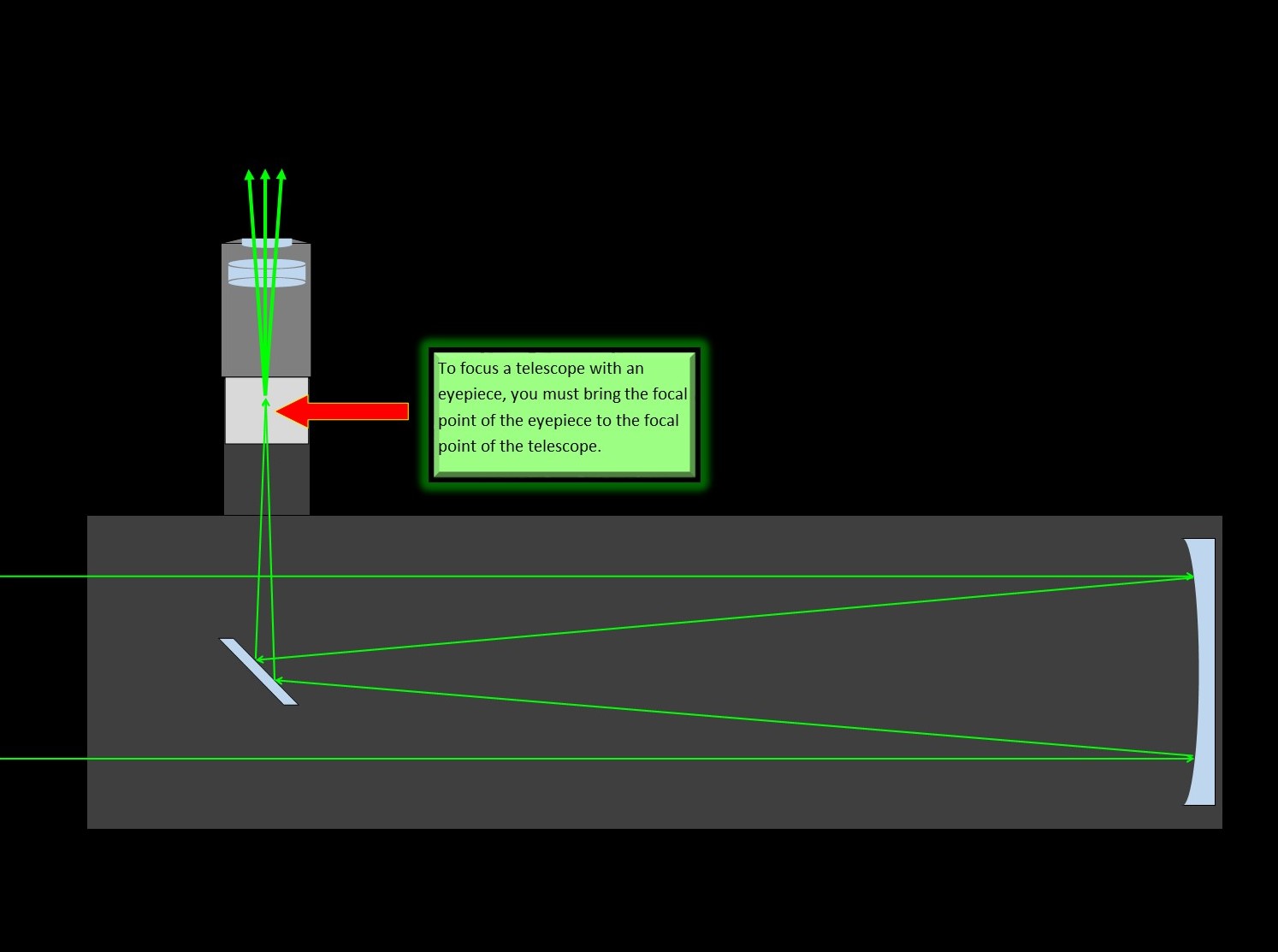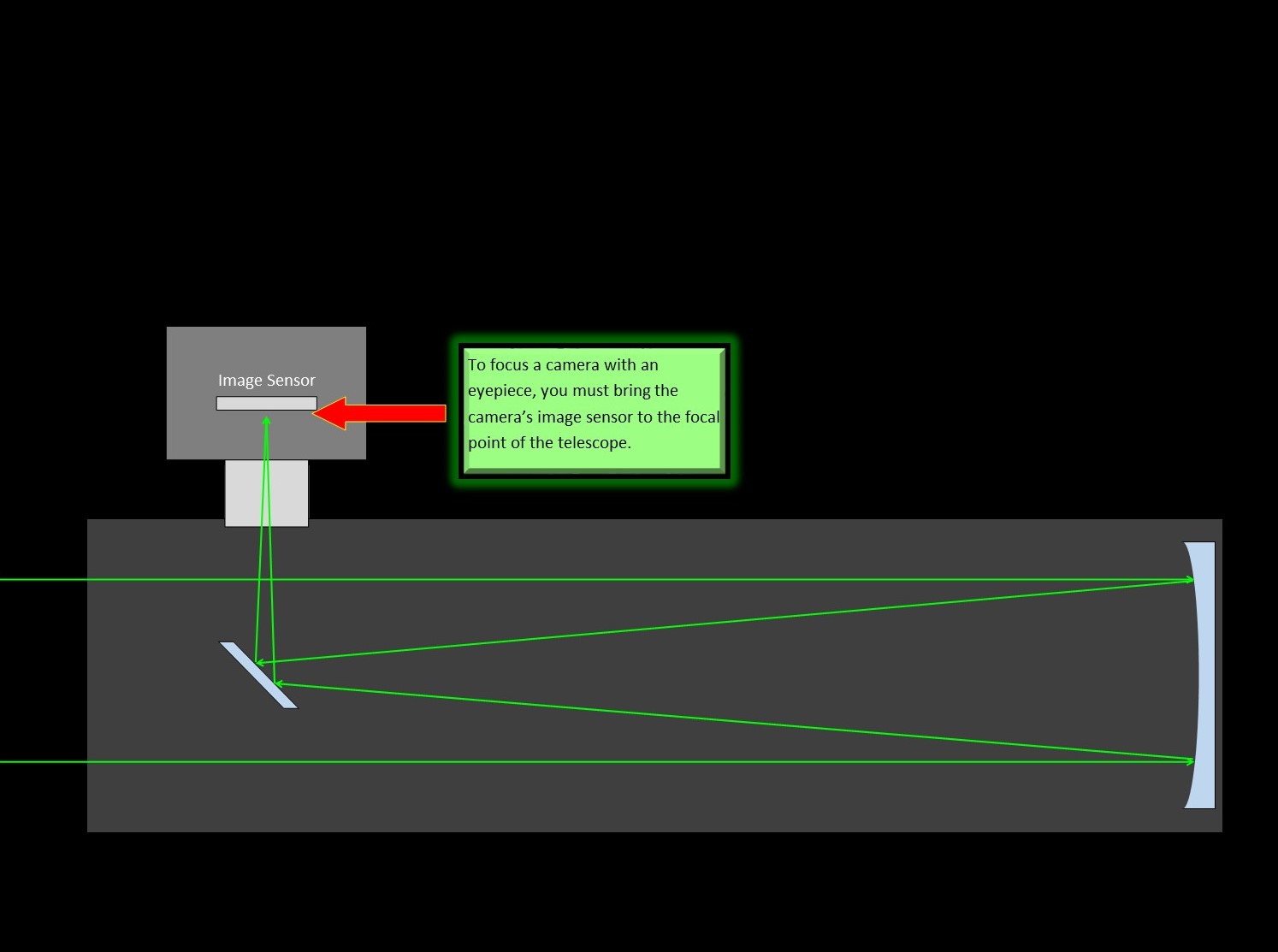Difference between revisions of "Problems Focusing A Newtonian Telescope With a Camera"
(Created page with " If a telescope is not designed for imaging, there is a fair chance that any attempt to connect a camera would fail. To understand why, let's first look at the design of a Ne...") |
m |
||
| Line 8: | Line 8: | ||
Both the telescope and the eyepiece have their own focal lengths. To achieve focus for an eyepiece, the focal point of the eyepiece and the focal point of the telescope must come together. | Both the telescope and the eyepiece have their own focal lengths. To achieve focus for an eyepiece, the focal point of the eyepiece and the focal point of the telescope must come together. | ||
| + | {| class="wikitable" style="margin:0 auto; margin-top:25px; margin-bottom:25px; padding:5px; width:500px;" | ||
| + | |[http://astro.jmhastronomy.com/otherpages/images/eyepiece_focus.jpg <img src="http://astro.jmhastronomy.com/otherpages/images/eyepiece_focus.jpg" width="500px" />] | ||
| + | |- | ||
| + | |style="font-family:Calibri, Helvetica, Sans-Serif; font-size:9pt;"|Diagram of path of light in a Newtonian OTA. | ||
| + | |} | ||
| − | |||
| + | The purpose of a focuser is to adjust the position of the eyepiece in relation to that of the telescope, this moves the eyepiece's focal point in and out so that you can adjust its position and reach focus. | ||
| − | + | The focal point of an eyepiece is typically found at the field-stop of the eyepiece. This is nearly always inside the barrel flange of the eyepiece. When you insert the barrel flange into the focuser receiver, it will put the eyepiece focal point INSIDE the focuser tube, hopefully to find the focal point of the telescope. | |
| + | But for a camera, things are a little different. | ||
| − | http://astro.jmhastronomy.com/otherpages/images/camera_focus.jpg | + | To focus a camera, you must get the camera's image sensor (or film, if you're using a film camera) to the focal point of the telescope. |
| + | |||
| + | |||
| + | {| class="wikitable" style="margin:0 auto; margin-top:25px; margin-bottom:25px; padding:5px; width:500px;" | ||
| + | |[http://astro.jmhastronomy.com/otherpages/images/camera.jpg <img src="http://astro.jmhastronomy.com/otherpages/images/camera.jpg" width="500px" />] | ||
| + | |- | ||
| + | |style="font-family:Calibri, Helvetica, Sans-Serif; font-size:9pt;"|In this image demonstrates that the image sensor is actually somewhat behind the front of the camera, away from the focal plane of the telescope. | ||
| + | |} | ||
| + | |||
| + | But the image sensor of a camera is going to be INSIDE the camera body, back by several millimeters from the front of the camera body. This means you need to move the camera inward further than you would an eyepiece. And here's where we run into a problem. | ||
| + | |||
| + | {| class="wikitable" style="margin:0 auto; margin-top:25px; margin-bottom:25px; padding:5px; width:500px;" | ||
| + | |[http://astro.jmhastronomy.com/otherpages/images/camera_focus.jpg <img src="http://astro.jmhastronomy.com/otherpages/images/camera_focus.jpg" width="500px" />] | ||
| + | |- | ||
| + | |style="font-family:Calibri, Helvetica, Sans-Serif; font-size:9pt;"|In order to focus, the image sensor must be brought to the focal plane of the optical tube. | ||
| + | |} | ||
| + | |||
| + | For most Newtonian telescopes, the focuser cannot move inward far enough to bring the image sensor to the focal point of the telescope. No matter how far in the focuser travels, you're still too far out from the focal point. | ||
| + | |||
| + | There are a few options, however. | ||
| + | |||
| + | The first solution is to use a Barlow Lens. The barrel flange of a Barlow will reach the focal point of the telescope, and extend it outward. This will USUALLY allow for focusing a camera. Of course, the down-side to this is the extend focal length and focal ratio, and this is not usually desirable for photography. | ||
| + | |||
| + | With most Newtonians, the focuser length outside the tube is around 3 inches or so. The second solution, then, is to replace the focuser with one that's shorter - what we call a low-profile focuser. Of course, this has a cost involved, and requires modification of the telescope. But it's probably the best option. | ||
| + | |||
| + | The last option is to modify the telescope itself in order to shift the focal point outward. The main method for doing this is to move the mirror forward in the tube. If the mirror is mounted in such a way that you can extend it forward, then this is the easiest method. I did this myself for one telescope. It had a set of 3 L-shaped brackets positioned 120° around the side of the mirror. They had two screws each that went from the front through the bracket to screw holes in the mirror cell behind the mirror. I found replacement screws that were 3/4 of an inch longer, removed the existing screws, put a 3/4 inch disc of wood behind the mirror itself, then put it back together with the longer screws. This pushed the mirror forward by 3/4 of an inch, which, in turn, pushed the focal point forward 3/4 of an inch in the focuser tube - right out of the tube and into a position that worked for a camera. It then was too far outward for an eyepiece, but this was easily fixed with an extension tube. Another option would be to trim the length of the tube where the mirror attaches by that amount and re-attach. This is likely to be more difficult to do right, however, and I'd recommend caution before attempting such a maneuver. | ||
| + | |||
| + | Of course, there's another problem with using a visual Newtonian for AP: the size of the secondary mirror. For visual use, manufacturers typically try to keep the size of the secondary as small as possible, only as largea s needed. For imaging, however, this is typically too small and doesn't provide even illumination to the sensor. You end up with significant vignetting this way. The only fix here is a new secondary... which is pretty major surgery. | ||
| + | |||
| + | But, all of this CAN be done, if you're stubborn enough. | ||
| + | |||
| + | |||
| + | |||
| + | ==Quick References== | ||
| + | *[http://www.televue.com/engine/TV3b_page.asp?id=154 TeleVue Advice and Information] | ||
| + | *[https://www.cloudynights.com/topic/468672-where-are-most-eyepiece-focal-planes-located/ An article on Cloudy Nights about eyepiece focal planes] | ||
Latest revision as of 17:32, 14 February 2019
If a telescope is not designed for imaging, there is a fair chance that any attempt to connect a camera would fail.
To understand why, let's first look at the design of a Newtonian reflector.
Light enters the telescope through the main aperture opening at the front-end of the telescope. It hits the primary mirror and is then redirected back toward the front of the scope. Because the mirror is curved, the reflection isn't straight-back, but angled inward, toward the secondary mirror. When it hits the secondary, it is then redirected through a hole in the side of the telescope.
Both the telescope and the eyepiece have their own focal lengths. To achieve focus for an eyepiece, the focal point of the eyepiece and the focal point of the telescope must come together.

|
| Diagram of path of light in a Newtonian OTA. |
The purpose of a focuser is to adjust the position of the eyepiece in relation to that of the telescope, this moves the eyepiece's focal point in and out so that you can adjust its position and reach focus.
The focal point of an eyepiece is typically found at the field-stop of the eyepiece. This is nearly always inside the barrel flange of the eyepiece. When you insert the barrel flange into the focuser receiver, it will put the eyepiece focal point INSIDE the focuser tube, hopefully to find the focal point of the telescope.
But for a camera, things are a little different.
To focus a camera, you must get the camera's image sensor (or film, if you're using a film camera) to the focal point of the telescope.

|
| In this image demonstrates that the image sensor is actually somewhat behind the front of the camera, away from the focal plane of the telescope. |
But the image sensor of a camera is going to be INSIDE the camera body, back by several millimeters from the front of the camera body. This means you need to move the camera inward further than you would an eyepiece. And here's where we run into a problem.

|
| In order to focus, the image sensor must be brought to the focal plane of the optical tube. |
For most Newtonian telescopes, the focuser cannot move inward far enough to bring the image sensor to the focal point of the telescope. No matter how far in the focuser travels, you're still too far out from the focal point.
There are a few options, however.
The first solution is to use a Barlow Lens. The barrel flange of a Barlow will reach the focal point of the telescope, and extend it outward. This will USUALLY allow for focusing a camera. Of course, the down-side to this is the extend focal length and focal ratio, and this is not usually desirable for photography.
With most Newtonians, the focuser length outside the tube is around 3 inches or so. The second solution, then, is to replace the focuser with one that's shorter - what we call a low-profile focuser. Of course, this has a cost involved, and requires modification of the telescope. But it's probably the best option.
The last option is to modify the telescope itself in order to shift the focal point outward. The main method for doing this is to move the mirror forward in the tube. If the mirror is mounted in such a way that you can extend it forward, then this is the easiest method. I did this myself for one telescope. It had a set of 3 L-shaped brackets positioned 120° around the side of the mirror. They had two screws each that went from the front through the bracket to screw holes in the mirror cell behind the mirror. I found replacement screws that were 3/4 of an inch longer, removed the existing screws, put a 3/4 inch disc of wood behind the mirror itself, then put it back together with the longer screws. This pushed the mirror forward by 3/4 of an inch, which, in turn, pushed the focal point forward 3/4 of an inch in the focuser tube - right out of the tube and into a position that worked for a camera. It then was too far outward for an eyepiece, but this was easily fixed with an extension tube. Another option would be to trim the length of the tube where the mirror attaches by that amount and re-attach. This is likely to be more difficult to do right, however, and I'd recommend caution before attempting such a maneuver.
Of course, there's another problem with using a visual Newtonian for AP: the size of the secondary mirror. For visual use, manufacturers typically try to keep the size of the secondary as small as possible, only as largea s needed. For imaging, however, this is typically too small and doesn't provide even illumination to the sensor. You end up with significant vignetting this way. The only fix here is a new secondary... which is pretty major surgery.
But, all of this CAN be done, if you're stubborn enough.